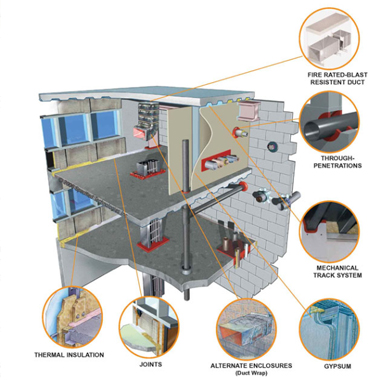

Where and How to Install Firestopping Products
Posted in Engineering, Fundamentals
Firestopping products are required by local building codes, national model codes, and the National Electrical Code (NFPA 70) to be installed in all penetrations of fire rated construction or in smoke barriers. Fire rated construction consists of walls, floors, shafts and listed floor/ceiling assemblies and are located throughout a structure as required by Code and indicated on the Architectural drawings. All through penetrations or membrane penetrations in these assemblies are required to be sealed to prevent the spread of fire or products of combustion (smoke).
A membrane penetration is an opening in one side of a wall (i.e. a receptacle), but does not go completely through the assembly (i.e. a pipe or conduit from a corridor into a tenant space). Types of fire rated construction are corridor walls, demising walls, HVAC shafts, elevator shafts, equipment rooms, floors and stair enclosures.
Penetrating items include, but are not limited to pipes, ductwork, conduits, cables, cable trays, outlet boxes. The annular space around these items are required to be filled by an approved fire blocking material. The annular space is the gap between the penetrating item and the fire rated surface. Depending on the type of construction and the fire rating of the surface, the type of fire stopping material and installation specifications will vary.
Firestopping material is available in many forms – putty, intumescent caulk, grout or mortar, pillows and boards to name a few. Putty is used on the back of outlet boxes for membrane protection. Intumescent products expand with heat to provide a tight seal between the penetrating item and the surface. Grout and mortar are used for penetrating concrete, brick or block construction. Pillows and boards are used for large penetrations such as cable trays and busducts. Each material has different requirements of installation from width of annular space the product is permitted to fill, depth of product in space, total area of installation, etc.
In most jurisdictions, the installation of firestopping material is required no matter the age of the building or structure. Anytime the authority having jurisdiction is on the premises, they could identify areas of non-compliance and cite the building owner whether or not the cited location is in an area with an active building permit. It is recommended to have a regular site inspection by the building maintenance staff and firestop any non-conforming penetrations. If additional information is required, please contact TES Engineering.
Image Credit: International Firestop Council (http://www.firestop.org/)

 Previous STORY
Previous STORY